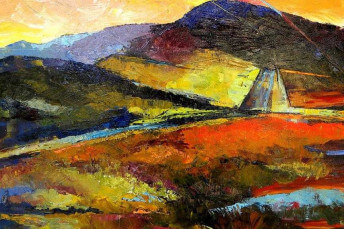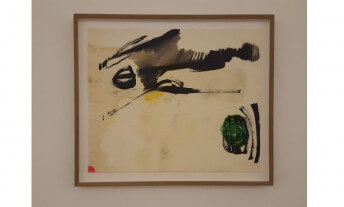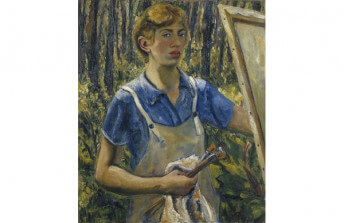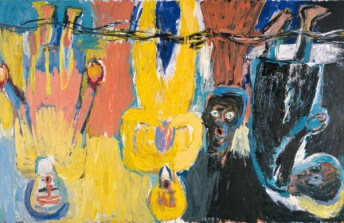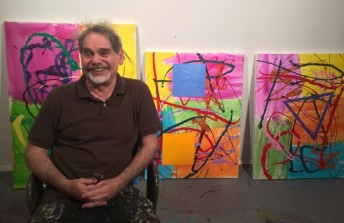Justice to Pissarro by Dana Gordon
Mar 20, 2017
For over a century, the painter Paul Cézanne (1839-1906) has been considered the father of modern art. His ascendancy, which began around 1894, had a tidal influence on the development of the avant-garde, leading to both abstraction and expressionism, commanding the fealty of Picasso and Matisse, dominating the standard narrative of the development of modernism through the late 20th century, and lingering today. But things did not always look this way. For most of the late 19th century, it was not Cézanne but the painter Camille Pissarro (1830-1903) who was revered as the greater master, and as one of the most influential creators of modern art. Thanks to the twists of history, however, Pissarro’s reputation subsequently ebbed to the point where he came to be recalled, often dismissively, as a vaguely important and skillful landscapist among the Impressionists and, dimly, as the first great Jewish modern artist.
Over the past quarter-century, in a quiet countermovement, Pissarro’s significance has been revived. Essays and exhibitions, including one at the Jewish Museum in New York in 1995, have shed new light on his achievement, suggesting in particular that Cézanne’s own career would not have been possible without the precedence of Pissarro. Recently abetting this trend has been a vibrant and informative show organized this past summer by the Museum of Modern Art (MOMA) in New York and now on tour [please note this exhibition took place in 2005 - ed.].
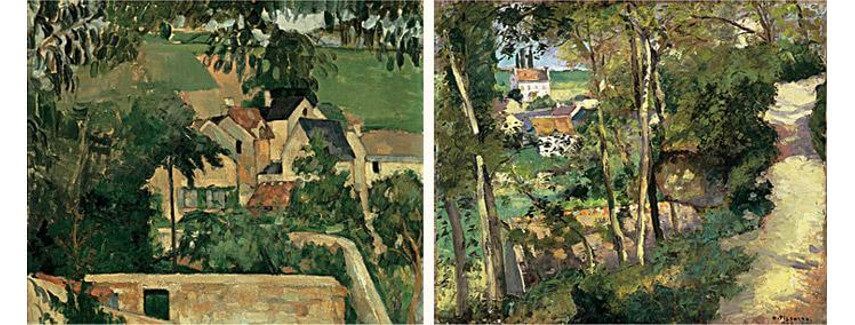 Paul Cézanne - Landscape, Auvers-sur-Oise, c. 1874, oil on canvas, 18 1/2 x 20 inches, © Philadelphia Museum of Art (Left) and Camille Pissarro, The Climbing Path, l'Hermitage, Pontoise, 1875, oil on canvas, 21 1/8 x 25 3/4 inches, © Brooklyn Museum of Art, New York (Right)
Paul Cézanne - Landscape, Auvers-sur-Oise, c. 1874, oil on canvas, 18 1/2 x 20 inches, © Philadelphia Museum of Art (Left) and Camille Pissarro, The Climbing Path, l'Hermitage, Pontoise, 1875, oil on canvas, 21 1/8 x 25 3/4 inches, © Brooklyn Museum of Art, New York (Right)
From 1861 until the mid-1880’s, Pissarro and Cézanne carried on a deep artistic and personal in- teraction that had a determining effect on the future of art. This interaction is the subject of the exhibit now on tour. But despite its many virtues, the show does not by itself illumine the full story of the Pissarro-Cézanne relationship, or of Pissarro himself; nor does it really make clear how to appreciate the latter’s work. Most cultured eyes still see early modern art, including Pissarro’s, through a Cézanne-derived screen, and a whole understanding of the modernist movement in art follows from this perception.
 Paul Cézanne - l'Hermitage at Pontoise, 1881, oil on canvas, 18 5/16 x 22 inches, © Von der Heydt-Museum Wuppertal, Germany (Left) and Camille Pissarro, Gardens at l'Hermitage, 1867-69, oil on canvas, 31 7/8 x 38 3/8 inches, © National Gallery, Prague (Right)
Paul Cézanne - l'Hermitage at Pontoise, 1881, oil on canvas, 18 5/16 x 22 inches, © Von der Heydt-Museum Wuppertal, Germany (Left) and Camille Pissarro, Gardens at l'Hermitage, 1867-69, oil on canvas, 31 7/8 x 38 3/8 inches, © National Gallery, Prague (Right)
Is it right? As far back as 1953, the abstract-expressionist painter Barnett Newman complained that the Museum of Modern Art, the temple of modernism in art, had “dedicated itself” to the proposition that Cézanne was “the father of modern art, [with] Marcel Duchamp as his self-appointed heir.” In so doing, Newman declared, the museum was perpetuating a “false history.” There is much to Newman’s charge.
Camille Pissarro was born on the island of St. Thomas in the Caribbean, a child of middle-class Jewish merchants originally from Bordeaux. Schooled in Paris from 1841 to 1847, he went back to the island to enter the family business, but eventually sloughed off his family’s expectations to go draw and paint in Venezuela. He returned to Paris for good in 1855, followed not long afterward by his parents.
In 1860, Pissarro began a liaison with Julie Vellay, his mother’s cook’s assistant. They married in 1871, had eight children, and remained together until Camille’s death in 1903. The relationship cost him a large part of his mother’s affections and financial support; as a consequence, most of Pissarro’s adult life would be a dire struggle for money. But his open and defiant commitment to Julie was an early example of the personal and artistic independence for which he became known. It also provided a kind of shelter for his friends Cézanne and Monet and their paramours during the family storms caused by their own pre-marital liaisons.
After the mid-1860’s, Pissarro took up residence in small towns just outside of Paris, where living was less costly and his favored rural motifs lay nearby. He made frequent trips into the city, often staying for days, but many artists also came out to visit and work near him—most notably Claude Monet for six months in 1869-70 and Cézanne and Paul Gauguin in the 1870’s and 80’s. Of Camille and Julie’s children, several became artists themselves, most prominently Lucien, the eldest son. Pissarro’s letters to Lucien offer a trove of insight into a painter’s life and into the history of 19th-century art.
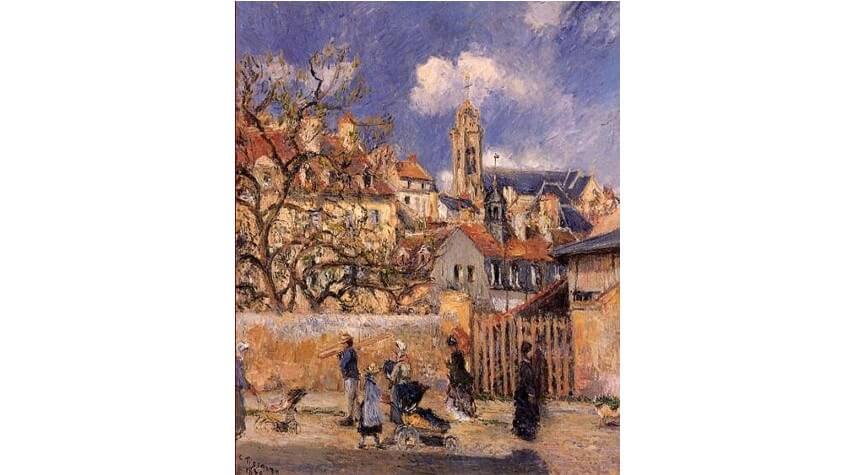 Camille Pissarro - 1878, Le Parc aux Charrettes, Pontoise, Private Collection
Camille Pissarro - 1878, Le Parc aux Charrettes, Pontoise, Private Collection
Pissarro was twenty-five when he returned to Paris from the Caribbean, already an experienced landscape painter and free of the stultifying conventions of the French academies. During the late 1850’s, he sought out his great predecessors in French art: Corot, Courbet, Delacroix, and others. Influenced by them, but never a disciple, he integrated what he learned into his own vision. At the same time as Edouard Manet, Pissarro developed a new approach emphasizing the full, direct response of the artist to the nature in which he exists.
Pissarro’s significance was recognized early on by his peers—and fitfully by officialdom. In the 1850’s, 60’s, and early 70’s, international “Salon” exhibitions offered the only hope for commercial success and acclaim in France. But admission was controlled by adherents of the Ecole des Beaux Arts, whose teachers held to a petrifying methodology. Vanguard artists had to deal with the Salons or, somehow, without them.
One of Pissarro’s unorthodox landscapes was accepted for the 1859 Salon, where it was noted appreciatively by the critic Alexandre Astruc. In 1863, his participation in the Salon des Refusés—a protest against the official Salon—made him anathema, but his work was so strong that it was nevertheless accepted for the Salons of 1864, ’65, and ’66. In his review of the last of these, Emile Zola, the great novelist and art critic, and a supporter of the avant-garde, wrote about Pissarro: “Thank you, Sir, your winter landscape refreshed me for a good half-hour during my trip through the great desert of the Salon. I know that you were admitted only with great difficulty.” In the same year, the painter Guillemet would write, “Pissarro alone continues to produce masterpieces.”
These early responses indicate clearly enough that Pissarro was creating something unusual. In fact, he was inventing abstraction, the ingredients of which he had gleaned from his precursors. As early as 1864, he was using elements of landscape as abstract designs, making lines and shapes be lines and shapes as well as representations of objects and scenic depth.
The “winter landscape” to which Zola referred, Banks of the Marne in Winter, was one of these works. Included in the MOMA show, it is full of the abstraction Pissarro was inventing. The trees on the left of the painting are an essay of lines, the houses on the right make up a play of triangular and trapezoidal shapes. The entire lower-right quadrant is a kind of “color-field” painting, concerned with the communicative powers of color and brushstroke independently of what they depict. The smudges of paint on the far right, standing in for houses, declare that smudges of paint carry qualities of beauty in their own right.
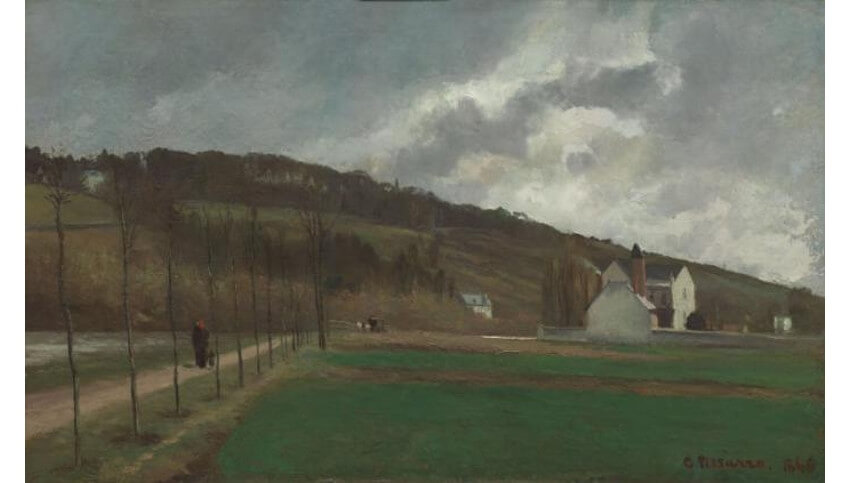 Camille Pissarro - The Banks of the Marne in Winter, 1866, oil on canvas 36 1/8 x 59 1/8 inches, © Art Institute of Chicago
Camille Pissarro - The Banks of the Marne in Winter, 1866, oil on canvas 36 1/8 x 59 1/8 inches, © Art Institute of Chicago
In addition to conveying a view of nature, and in addition to being visual essays made up of lines, colors, and forms, Pissarro’s paintings were an expression of his own ideas and feelings. That is, the way he painted—his brushstrokes, his “facture”— made the viewer aware of the emotions of a specific person at a specific moment in time. In the avant-garde of that era, there was, indeed, a great deal of interest in the expression of the self in art. Terms like “temperament” and “sensation” were gaining currency, particularly in descriptions of Pissarro’s art. As Zola would write of him in a review of the 1868 Salon:
The originality here is profoundly human. It is not derived from a certain facility of hand or from a falsification of nature. It stems from the very temperament of the painter himself and comprises a feeling for truth resulting from an inner conviction. Never before have paintings appeared to me to possess such an overwhelming dignity.
In the late 1860’s and early 70’s, Monet, Pierre Auguste Renoir, Frédéric Bazille, Alfred Sisley, and Pissarro worked, in Pissarro’s words, like “mountaineers roped together at the waist.” In 1869 they painted along the Seine, engaged by the colored shapes presented by the water’s reflections. The resulting works, especially Renoir’s and Monet’s, are justly famous as among the first fruits of Impressionism. As for Pissarro’s role in that movement, it has been sadly obscured by the fact that nearly all of his paintings from that time are lost. An estimated 1,500 pieces, 20 years’ work, were destroyed in the 1870-71 Franco-Prussian war when the Prussians occupied his home. (He and his family had managed to escape to London.)
Monet has often been represented as the genius of Impressionism, and a genius he certainly was. He was also the instigator of the first Impressionist exhibition in 1874. Nevertheless, in a review of that show, the critic Armand Silvestre could refer to Pissarro as “basically the inventor of this painting.” One can see why.
Because of Monet, Impressionism came to be thought of as an art of color and light, an art in which structure and composition played lesser roles. But Pissarro’s Impressionist landscapes and townscapes of the 1870’s are a different story. Justly celebrated for their observation of light, color, and atmosphere, and for the natural appearance of the people and places in them, these commanding, lyrical works also extend the artist’s exploration of structure and composition. The “process of visual dissection” one observes in these paintings—the phrase is Christopher Lloyd’s, in his 1981 monograph Camille Pissarro—is Pissarro’s particular triumph, and it makes Monet’s paintings, beautiful as they are, look picturesque and simplistic by comparison. Not for nothing did Zola insist that “Pissarro is a fiercer revolutionary than Monet.”
And Cézanne? For over 20 years, from the time they met in 1861, he sought and received Pissarro’s advice and help. The young Cézanne, awkward in art as in person, was ridiculed in Paris—but not by Pissarro, who, perhaps seeing something of himself in the impolitic frankness of the younger man’s work, recognized his unusual talent immediately and never faltered in his support.
The two became close friends; by the early 1870’s, Cézanne was so eager to work in Pissarro’s company that he moved near him. That they influenced each other is beyond doubt. “We were al- ways together!,” Pissarro wrote of those years, when the volatile Cézanne’s attachment was intense. In particular, Pissarro’s obsessive approach to work, to mining his own vision, helped Cézanne to release his blocked personality, showing him how emotional content would come on its own and allowing him to channel his anxious energy into the formal problems of painting.
From Pissarro, Cézanne learned abstraction, the expressive little brushstroke, emphasis on form rather than sentiment, and how to make form with color and without outline. Frequently, the two artists painted the same view at the same time; a number of the resulting pictures were hung next to each other at the MOMA show, giving the viewer an extraordinary “you are there” sensation. In the mid-1870’s, Cézanne began a long seclusion in Aix, near the Mediterranean, removing himself from the Paris scene almost entirely. From there, in 1876, he wrote to Pissarro, “It’s like a playing card. Red roofs against the blue sea.” He was acknowledging that he was painting the roofs, walls, and fields in Aix as flat, abstract forms dominated by shape and color, as Pissarro had painted ten years earlier.
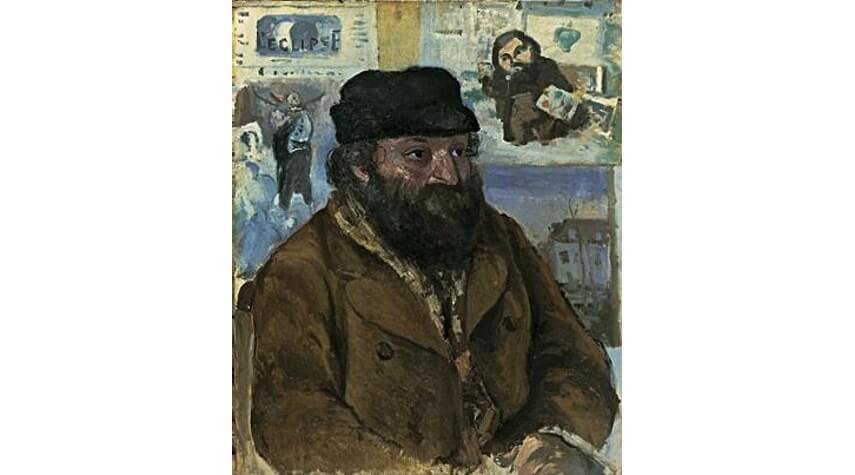 Camille Pissarro, Portrait of Cézanne, 1874, oil on canvas, 28 3/4 x 23 5/8 inches, collection of Laurence Graff
Camille Pissarro, Portrait of Cézanne, 1874, oil on canvas, 28 3/4 x 23 5/8 inches, collection of Laurence Graff
During the long years prior to Cézanne’s breakthrough, Pissarro provided virtually all the exposure for his work. He encouraged the merchant Père Tanguy to show Cézanne’s work at his paintshop-gallery, and urged collectors and artists to see it there. Later he convinced a new art dealer, the soon-to-be-famous Ambroise Vollard, to give Cézanne the 1895 show that made his name.
Later in life, Cézanne said that “Pissarro was like a father to me: he was a man you turned to for advice, and he was something like le bon Dieu.” It is possible that Cézanne was somewhat intimidated by this divinity. At MOMA, Pissarro’s awesome Kitchen Garden of 1877 was hung next to Cézanne’s painting of the same subject in the same year, The Garden of Maubuisson. Cézanne’s version has its beauty—but, when seen with the Pissarro, it feels like a sketch, a few notations of musical ideas. By contrast, the Pissarro has the force of a great symphony.
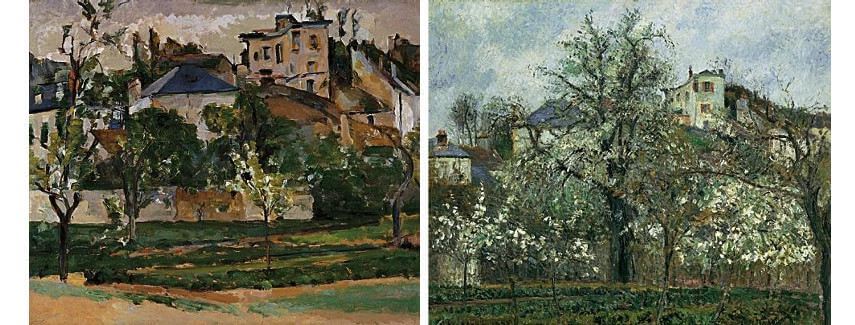 Paul Cézanne - The Garden of Maubuisson, Pontoise, 1877, oil on canvas, 19 3/4 x 22 5/8 inches, collection of Mr. and Mrs. Jay Pack, Dallas, Texas, photo by Brad Flowers (Left) and Camille Pissarro - Kitchen Garden, Trees in Flower, Spring, Pontoise, 1877, oil on canvas, 25 13/16 x 31 7/8 inches, Museé d'Orsay, Paris, Gustave Caillebotte Bequest, 1894 © Réunion des Musées Nationaux / Art Resource, NY, photo by Pascale Néri (Right)
Paul Cézanne - The Garden of Maubuisson, Pontoise, 1877, oil on canvas, 19 3/4 x 22 5/8 inches, collection of Mr. and Mrs. Jay Pack, Dallas, Texas, photo by Brad Flowers (Left) and Camille Pissarro - Kitchen Garden, Trees in Flower, Spring, Pontoise, 1877, oil on canvas, 25 13/16 x 31 7/8 inches, Museé d'Orsay, Paris, Gustave Caillebotte Bequest, 1894 © Réunion des Musées Nationaux / Art Resource, NY, photo by Pascale Néri (Right)
Around this time, Cézanne’s technique was evolving into repetitive arrangements of strokes. This so-called “constructive-stroke” technique was implied in many earlier Pissarro paintings as well, including, in the MOMA show, The Potato Harvest (1874) and, explosively, L’Hermitage in Summer, Pontoise (1877), an astonishing composition dense with essays of brushstroke and the poetry of color planes. But, except for a few paintings explicitly experimenting with Cézanne’s technique (three from 1883-84 were in the MOMA show), Pissarro never really adopted it, preferring instead to give individual meaning to every moment and stroke in the composition.
To be sure, Cézanne’s marks add up: every spot in his mature painting is oriented toward the frontal impact of the whole, with the overall tension of the surface creating the sense of flatness that carried so much influence in the later development of abstract art. In the viewer’s perception, everything in a Cézanne painting pushes forward, all the marks of paint moving together like lattice-work. This forward push of the thin, pulsating surface came more and more to be the dominant note in Cézanne’s paintings. But it was achieved at the cost of his own declared wish “to make out of Impressionism something solid and durable, like the art of museums.”
Cézanne acknowledged this cost, writing that “coloring sensations force me to produce abstract passages that stop me from covering my whole canvas or from pushing to the full delineation of objects.” In other words, he could not complete the paintings as scenes or as recognizable objects because he had already completed them as compositions of purely visual events. His use of techniques of abstraction richly enforced but did not get much beyond the impression of overall flatness.
Pissarro’s paintings, by contrast, have tremendous depth. They invite you in; you can enter and breathe and look around both the abstraction and the depicted scene, as if taking a tour of the artist’s thought process. (In this connection, it is especially instructive to compare two paintings included in the MOMA show, Pissarro’s intricate The Conversation [1874] with Cézanne’s House of the Hanged Man [1873].) But Pissarro’s fullness, warmth, and solidity are not what later painters got from the early abstract artists, or what became the accepted taste of the 20th century. Instead, they got Cézanne’s flatness and assertion of color, often without the high quality of painting that made Cézanne’s own work so convincing.
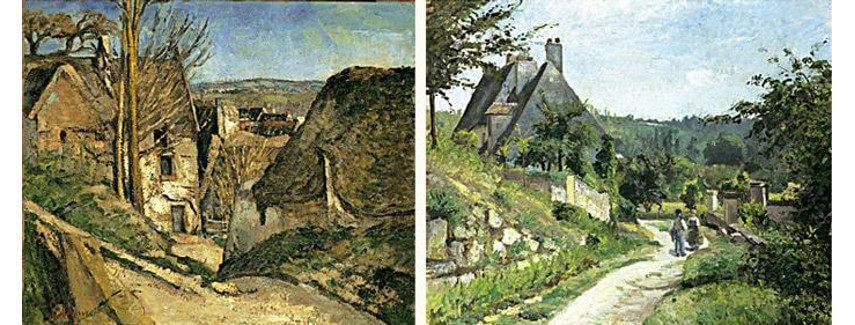 Paul Cézanne - The House of the Hanged Man, Auvers-sur-Oise, 1873, oil on canvas, 21 5/8 x 16 inches, Musée d'Orsay, Paris. Count Isaac de Camondo Bequest, 1911 © Réunion des Musées Nationaux / Art Resource, NY, photo by Hervé Lwandowski (Left) and Camille Pissarro - The Conversation, chemin du chou, Pontoise, 1874, oil on linen, 23 5/8 x 28 3/4 inches, Private Collection (Right)
Paul Cézanne - The House of the Hanged Man, Auvers-sur-Oise, 1873, oil on canvas, 21 5/8 x 16 inches, Musée d'Orsay, Paris. Count Isaac de Camondo Bequest, 1911 © Réunion des Musées Nationaux / Art Resource, NY, photo by Hervé Lwandowski (Left) and Camille Pissarro - The Conversation, chemin du chou, Pontoise, 1874, oil on linen, 23 5/8 x 28 3/4 inches, Private Collection (Right)
“Pissarro was possessed of a remarkable eye that led him to appreciate the genius of Cézanne, Gauguin, and [Georges] Seurat before all other painters,” wrote Françoise Cachin, the director of the Musées de France, in 1995. This is very true, and it applies to more painters than she named.
Gauguin was Pissarro’s protégé for many years, and his mature work, seemingly very different from Pissarro’s, is full of the latter’s inventions. Vincent van Gogh, the troubled genius who arrived in Paris in 1886, also spent time with Pissarro, learning from him that, as he would later write, “you must boldly exaggerate the effects of either harmony or discord which colors produce.” Vincent’s brother Theo, an art dealer in Paris, was another Pissarro enthusiast, whose death in 1891 dealt a blow to Pissarro’s commercial hopes.
Nor were Gauguin and Van Gogh the end of it. In the mid- to late-1880’s, Pissarro would be accused of aping the neo-Impressionism and pointillism of the much younger Seurat and Paul Signac. But Pissarro did not follow them, he led them. Although Seurat certainly had his own sensibility, all of his work’s stylistic attributes can first be found in Pissarro: the color theory, the tightly compacted strokes, the way the dots of paint coalesce into abstract patterns, even the stiff hieratic figures. One can trace, in specific paintings, what Seurat learned from Pissarro, even as Pissarro went deeper into the human spirit and saw farther into the future.
In the 1890’s Pissarro developed a new aesthetic density in his complex cityscapes, figure paintings, and landscapes. These, although less well known today than his earlier landscapes, made a strong impact, most notably on Henri Matisse (1869- 1954). The meeting in 1897 of this struggling young painter, who would rightly come to be considered the greatest artist of the 20th century, with the living embodiment of painting’s long journey in the 19th moved Matisse to tears. He came away likening Pissarro to the long-bearded figure of the prophet Moses as sculpted on the Well (or Fountain) of Moses, a well-known Gothic masterpiece in Dijon.
Pissarro was indeed a Jew with a long white beard and a biblical mien, and Matisse was hardly the first to liken him to Moses. But Matisse may have been thinking less of the figure and more of the fountain—of Pissarro as a living source, with a flowing generosity of spirit. He certainly saw in Pissarro an exemplary survivor of a long, difficult life dedicated to art. If, later on, when Pissarro was no longer so esteemed, Matisse spoke less of him and more of Cézanne, in 1898 he was frequently in the apartment Pissarro had rented to paint his views of the Tuileries. Pissarro was Matisse’s master, present in his work in many ways, including some later attributed to Cézanne.
Pissarro was also still a presence in 1900-01 when Pablo Picasso entered the Paris art world, and his touch and his inventions can be seen both in the dense little brushstrokes of the classical cubism associated with Picasso and Georges Braque and in the flat, colored planes of later cubism. Many later painters, too, including those who sought an abstraction free of the constrictions of cubism, carried a Pissarro gene, whether or not they were aware of it.
Testimonies to Pissarro’s unique character have come down to us through personal recollections and through his interactions with other artists. Though not shy about his own work, he was neither a raging egotist nor a pushy self-promoter— two useful personas for an artist. He was generous in sharing his insights and, as we have seen, unself ish in the support he gave to others. “The first thing that struck one in Pissarro,” Ambroise Vollard observed, “was his air of kindness, of delicacy, and at the same time of serenity.” Thadée Natanson, editor of La Revue Blanche in the 1890’s, recalled him as “infallible, infinitely kind and just.” In the phrase of Christopher Lloyd, whose writings have contributed greatly to the revival of Pissarro, he played an “almost rabbinical role” in French painting.
Unfortunately, history finds personality an easier subject than art, and Pissarro’s personality has on occasion been invoked either to diminish or, conversely, to justify his work, in both cases with a distorting effect. At one point, for instance, his long-lived enthusiasm for anarchism was held against him. (“Another mistake of Pissarro’s in which is manifest a certain pretension to socialist political activity,” wrote a critic in 1939, deprecating a pastel of peasant women chatting under a tree.) In our own age, by contrast, his anarchism has counted for him: thus, in a 1999 essay, the influential Marxist art historian T.J. Clark committed pages of exotic political exegesis to a pointless effort to attach Pissarro to far-Left politics. In fact, the painter stood foursquare against the usurpation of art by politics or any other cause. “The art that is most corrupt,” he maintained, “is sentimental art.”
And then there is Pissarro’s Jewishness. Did it, perhaps, play a role in the eventual eclipse of his stature? Though he did not participate in religious formalities, Pissarro never dissimulated his Jewish identity—to all appearances, he enjoyed it. But anti-Semitism was rife in all social classes in the France of the 1860’s and later, despite the constitutional guarantees of freedom of religion instituted under Napoleon I. By the 1890’s, when France had become a republic, there were anti-Semitic riots during the panic over anarchism, and then the Dreyfus affair.
The avant-garde was itself tinged with anti-Semitism. Cézanne took the side of the anti-Dreyfusards. Both Degas and Renoir—old friends and admirers of Pissarro—disparaged him in anti-Semitic terms, and worried about being associated with him. Here is Renoir, in 1882: “To continue with the Israelite Pissarro, that taints you with revolution.”
Still, one can make too much of this. Anti-Semitism does not appear to have been the main determinant in the avant-garde’s view of Pissarro. He was, to say the very least, accepted as one among them. Indeed, it is possible that some of Pissarro’s contemporaries considered his Jewishness an important and positive element in what he brought, both to the art of painting and to the art of human existence. In likening Pissarro to Moses, the giver of the law, Matisse and others were undoubtedly paying tribute not only to his new way of seeing but to his way of living—moral, responsible, whole. Whatever complex of factors explains the ebbing of his reputation, his Jewishness seems to have played, at most, a minor role in it.
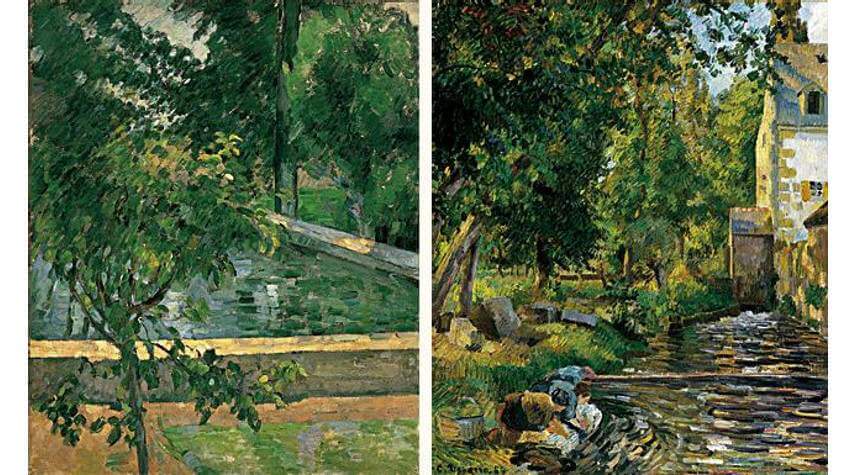 Paul Cézanne - The Pool at Jas de Bouffan, c.1878-79, oil on canvas, 29 x 23 3/4 inches, Albright-Knox Art Gallery, Buffalo, New York (Left) and Camille Pissarro - Washing House and Mill at Osny, 1884, oil on canvas, 25 11/16 x 21 3/8 inches, Private Collection, Photo courtesy of Richard Green, London
Paul Cézanne - The Pool at Jas de Bouffan, c.1878-79, oil on canvas, 29 x 23 3/4 inches, Albright-Knox Art Gallery, Buffalo, New York (Left) and Camille Pissarro - Washing House and Mill at Osny, 1884, oil on canvas, 25 11/16 x 21 3/8 inches, Private Collection, Photo courtesy of Richard Green, London
Since 1980, much of the writing on Pissarro has implicitly conceded his primacy—but not his preeminence. “It sounds almost as if Cézanne was borrowing Pissarro’s eyes,” observes the MOMA catalog in discussing one of the exhibit’s paintings. Or again: “Every work produced by Cézanne at that point [1881] appears to refer to an earlier painting by Pissarro.”
This diffidence—“almost as if,” “appears to refer”—is altogether misplaced. Many of Pissarro’s great contemporaries considered him the greatest of them all, and anyone looking today for the true sources of modern painting can find them most wholly and harmoniously present in him. Just as Barnett Newman was right in 1953 to decry the “false history” that holds Cézanne to be the father of modernism in art, Cézanne himself was right in maintaining, “We are all derived from Pissarro.”
Featured image: Camille Pissarro - L'Hermitage in Summer, Pontoise (detail), 1877, oil on canvas, 22 3/8 x 36 inches, © Helly Nahmad Gallery, New York
All images used for illustrative purposes only
The text was originally published at: www.painters-table.com and Commentary Magazine.
Submitted by Dana Gordon on March 20, 2017

